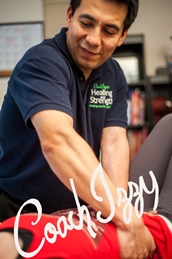Those who have experienced Counterstrain know how gentle but powerful it is. But in this group, there are those who also know that, despite its gentleness, Counterstrain can produce some significant post-treatment effects.
For those who experience them, the effects usually last 24 hours. Occasionally, some will feel them for 48 to 72 hours, but eventually, after the post-treatment effects subside, everyone enjoys the benefits of Counterstrain.
Will you be one of those who experience post-treatment effects?
If we’re talking at the individual level, I don’t know yet. I’ll have a much better idea after your session.
But in general terms, it’s worth knowing that if you experience post-treatment effects, what you feel is not necessarily a single sensation, but rather, a spectrum of reactions that vary widely from person to person. Some of the most common are:
Occasionally, some may experience:
So, what determines what you’ll feel?
Experience has shown me that the factors that influence your treatment plan, number of sessions, and return to activity will also influence how you’ll feel after treatment. For instance:

Your Medical History – In general, those with a history of systemic conditions (MS, Lyme disease, Crohn’s, Celiac, severe allergies, etc.), intensive treatments (chemotherapy, radiation, large doses of antibiotics, etc.), multiple surgeries, or multiple traumas, tend to experience the most post-treatment effects.
Length of the dysfunction – In general, the longer you’ve been harboring the dysfunction, the greater the chances you’ll experience some post-treatment effects. Keep in mind that the time you experienced symptoms is not necessarily the time you’ve harbored the dysfunction.
Age – In general, the older you are, the greater the number of dysfunctions you may have, thus, the greater the likelihood you’ll experience post-treatment effects.
Previous exposure – Those who receive Counterstrain in a maintenance basis rarely experience post-treatment effects, and if they do, it’s mild. This seems to wear off, though, if the patient goes 4 or more months without treatment.
Physical fitness – My most reliable predictor and the big equalizer. Physically fit individuals fare the best, regardless of age or other factors. They rarely experience post-treatment effects, and if they do, it’s short lived. What an excellent reason to emphasize productive strength training and fitness in our lives.
What to Do?
Remember that the discomfort dissipates in 24 hours for most, and that there are a few tried-and-true methods to help you ease the process:
Sleep – Get a full night rest, and if you need more, take a couple of 10 minute naps during the day.
Warm showers – Even more helpful prior to bed.
Contrast showers – 30 seconds to 1 minute of cold, followed by 2 minutes of warm. Can be done systemically or applied to a specific area.
Epsom salt baths – Enough said! Enjoy.
Arnica – Popular in homeopathic medicine, it can be used in gel, oil, or pellet form. Consult with your physician if you have concerns.
Leisure walking – About a mile of a gentle walk can help you clear your head and body.

Remember, I’ll have a better idea how you’ll react only after your session, and if I give you the heads up, please pay attention. I can’t tell you how many times I had the skeptics laugh at my warnings only to contact me in astonishment the day after.
Overall, this will be a great time to meditate, embrace patience, and respect your body. After all, it’s only letting you know that you need to rest so it can continue the healing process.
Until next time, may you enjoy a fit and pain-free life!

